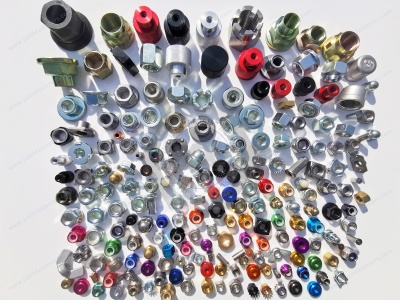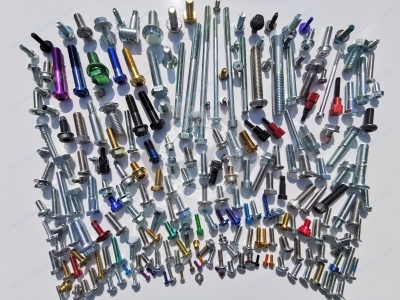Call Us
+86 136 6007 9809
Call Us
+86 136 6007 9809
Jun. 20, 2024
Quality Assurance Measures for Automotive High-Strength Fasteners
Most of the bolts produced in large quantities need upsetting, and most of the steel used is cold-heading steel. In modern automobile manufacturing, more than 40% of the parts have threaded structure structures, in addition to simple positioning bolts, such as connecting rod bolts, cylinder head bolts, etc., by the role of axial preload tensile load. Still, it is also in the process of additional axial tensile (alternating) load, transverse shear (alternating) load, or the resulting composite bending load, and sometimes there are impact loads. Typically, additional transverse alternating loads cause loosening of the bolt, axial alternating loads cause fatigue fracture of the bolt, while in the role of environmental media, axial tensile loads cause delayed fracture of the bolt. While reducing costs, fastener users propose substantial weight reduction and ultra-high-strength to resist elongation, pull-off, slip, and wear; reliable toughness to minimize deflection sensitivity, notched stress concentrations, and surface quality; bolts operating in humid or corrosive atmospheres requires sufficiently low sensitivity to delayed fracture and good cold heading properties.
It's worth noting that the automobile production and manufacturing of bolts used in the strength level can be divided into 4.6 ~ 1 2.9 level, etc. 6.8 level of bolts below the level of most of the use of low carbon steel manufacturing, without heat treatment; 8.8 level of general ML35 steel, can also be used in the manufacture of low carbon manganese steel, 9.8 level of bolts commonly used in the manufacture of carbon and boron steel, more than 10.9 level of most of the use of alloy structural steel manufacturing. However, the current trend in the automobile industry is the increasing use of high-strength bolts for 10.9 grade, and the amount is gradually expanding.
Steel 12-Point Screws: Good for high-strength fastening, these screws are made from steel comparable in strength to Grade 9 steel. They are used for heavy-duty stamping applications and earth-moving machinery, such as bulldozers and excavators. The head makes 12 points of contact with a wrench to handle more torque than a socket head or hex head screw. The flange distributes pressure where the screw meets the surface, eliminating the need for a separate washer. To install, use a 12-point wrench that matches the head width of your screw.
Coarse Thread—Coarse threads are the industry standard; choose these screws if you don't know the pitch or threads per inch.
Fine Thread—Fine threads are closely spaced to prevent loosening from vibration.
IFI-115—Screws that meet IFI 115 comply with these specifications for dimensions.
Black Oxide—Black-oxide-coated screws are mildly corrosion-resistant in dry environments.
Length—Length is measured from under the flange.
Thread Spacing—Match the thread spacing of mating components.
Head Height—Head height includes the flange.
High-Strength Metric Class 10.9 Steel Hex Head Screws: Choose these Class 10.9 steel screws for high-stress applications, such as valves, pumps, motors, and automotive suspension systems. They are at least 25% stronger than medium-strength steel screws. Dimensions meet ISO (formerly DIN) or DIN specifications. Length is measured from under the head.
Steel screws should be used in dry, noncorrosive environments. Zinc yellow-chromate plated and zinc-plated steel screws resist corrosion in wet environments. Blue-dyed screws are easy to distinguish. Black corrosion-resistant coated steel screws resist chemicals and withstand 1,000 hours of salt spray. To maintain corrosion resistance, use these screws with black ultra-corrosion-resistant-coated nuts and washers.
Match the thread spacing of mating components. Coarse threads are the industry standard; choose these screws if you don't know the pitch. Fine and extra-fine threads are closely spaced to prevent loosening from vibration; the finer the thread, the better the resistance.
For high-quality High-Strength Metric Class 10.9 Steel Hex Head Screws fasteners and professional technical support, don't hesitate to co don't us at adelajonly@gmail.com or visit our website at [Juxin Fasteners]: https://www.juxinfasteners.com.
With the high performance of automobiles and engines and material application stress increase, part size reduction, and lightweight chassis, the bolt puts forward higher design stress and lightweight requirements, and the most effective measure is to improve the use of steel for bolt strength. Reducing the S content can improve the deformation capacity of steel, and reducing the P content can reduce the deformation resistance of steel. At the same time, it can reduce the P and S in the grain boundary of the bias and reduce the grain boundary embrittlement. Reducing S can also lessen the non-metallic inclusions in steel and improve its toughness and plasticity. Therefore, reducing steel's P and S content can improve steel's cold heading performance and delay fracture resistance.
Experiments show that the S content dramatically influences the tendency of 45 steel to crack, and the reduction of S content can reduce this tendency significantly. Usually, 8.8-grade bolts are manufactured with ML35 and SURCH35K steel. ML35 is a typical conventional cold heading steel; when the size of the cross-section is different at the same time, ML35, due to the degree of quenching, is different; although the same tempering process, its mechanical properties are not the same. The larger the cross-section, the lower the degree of hardening and the worse the mechanical properties. After quenching and high-temperature tempering, the surface layer and the heart differ in their microstructures, even though they achieve similar hardness. The surface layer is tempered sohnite while the heart is still lamellar pearlite organization. The cross-section of the organization is not uniform, and the performance is not uniform.1 0.9 grade bolts are generally made of 40Cr, 35CrMo ~ 9. Still, due to the boron steel's low ability to resist tempering stability, 40B, 40MnB ~ its tempering temperature is lower than that of low alloy steels 80 ~ 1O0 ~ C. Therefore, the delayed fracture susceptibility of the boron steel made of 10,9-grade high-strength bolts is significant.
Developing low-cost, low and medium-carbon high-strength boron steel is a promising solution to further enhance the cold heading performance and eliminate the need for spherical annealing treatment. The basic principle of its composition design is to reduce the carbon content, thereby improving the steel's deformation ability. A trace of boron is added to compensate for the loss of strength and hardenability due to the reduction of carbon. An appropriate amount of Cr, Mn, and other alloying elements are included to enhance the hardenability further. Due to the low carbon and alloying elements content, the steel exhibits good cold working performance, allowing the rolled material to be directly drawn and undergo cold upsetting processing without needing pre-spheroidal annealing treatment. This improves the manufacturing process and saves the cost of producing bolts.
Cheap B steel can replace the original high-priced alloy containing Ni, Cr, Mo, etc. Manufacture of bolts with non-quenched steel can be omitted before the bolt cold-drawn spheroidal annealing and quenching and tempering of bolts after shaping, but also reduce the tendency of decarburization of the threaded tip to improve the yield of the thread, the economic effect is noticeable. Non-tempered steel coils in cold working hardness are usually higher, reducing the processing mold life, so non-tempered steel manufacturing bolts are mainly 8.8 grade. A small amount of 1 0.9 grade double head bolts can also be used in non-quenched steel, and its use is gradually expanding.
They currently used non-quenched steel, the organization of low-carbon manganese-containing ferrite + pearlite type and body type, and micro-alloying elements such as Nb, V, Ti, and other grain refinement and precipitation strengthening elements. The use of extra-furnace refining to reduce inclusions and control the composition in a narrow range, through the control of NSLN and control of cooling, refinement of the organization to improve toughness and produce precipitation strengthening, Given the fluctuations in the mechanical properties of non-tempered steel rolled material directly affect the overall performance of the bolt, the metallurgical process control of non-modulated steel is very critical. Some manufacturers have attached great importance to applying non-quenched steel; instead of SWRCH35K production of 8.8 high-strength bolts, mechanical properties are better than the tempered SWRCH35K. These new low-carbon bainitic steel prices are high, but it is a promising new material.
Heat treatment of fasteners, in addition to general quality inspection and control, there are some special quality inspection and control. In the threaded fastener, testing can be based on more than just the hardness value; check the relevant manuals and convert it into strength value. There is a hardenability factor in the middle.


In general, the hardenability of the material is good, the hardness of the cross-section of the screw part can be evenly distributed. The strength and guarantee stress can also meet the requirements if the hardness is qualified. However, when the hardenability of the material could be better, although according to the prescribed part of the check, the hardness is competent, the strength and guarantee stress often fail to meet the requirements. Especially when the surface hardness tends to the lower limit, the lower limit value of hardness is usually increased to control the strength and guarantee stress in the qualified range. Retemperingg test 8.8 ~ 1 2.9 grade bolts, screws, and studs shouldRetemperingg the actual production of the lowest tempering temperature lower 1 0 ℃ insulation 30minretemperingg test. In the same specimen, before and after the test, retemperingnce between the average of the three hardness points shall not exceed 20 HV. The theretemperingg test can check whether the quenching hardness is insufficient; Retemperingg of too low-temperature tempering can barely reach the specified hardness range of the practice to ensure comprehensive mechanical properties. Shallow carbon martensitic steel is made of threaded fasteners and uses low-temperature tempering. Although other mechanical properties can meet the requirements, the guaranteed stress measurement and residual elongation fluctuations are extensive and much more significant than 1 2.5 um.
In some cases, conditions will cause a sudden fracture phenomenon. In some automotive bolts, there has been a sudden fracture phenomenon. When the lowest tempering temperature tempering, can reduce the above phenomenon
Susceptibility to hydrogen embrittlement increases with the strength of the fastener. Externally threaded fasteners of grade 10.9 and above or surface-hardened white tapping screws and combination screws with hardened steel washers, etc., should be dehydrogenated after plating. Dehydrogenation is generally carried out in an oven or tempering furnace at 190 to 230% for more than 4 hours to diffuse the hydrogen. Threaded fasteners can be used to spin a tight approach in a particular fixture, spinning to make the screw withstand considerable guaranteed stress under tension; keep 48 hours after loosening the threaded fasteners do not produce fracture.
With the development of automotive and machinery industries, the use of fasteners put forward more and more high requirements, such as automotive, motorcycle high-performance and lightweight, steel put forward a new function, which does not reduce the cost of the part itself but has the potential to reduce the total cost of the machine or component. Experiments have shown that after adding Ni, Cr, Mo, and other elements, the price of the material itself is bound to increase, but the bolt's resistance to delayed destruction of the strength has been improved, and the original compared to the diameter of the bolt is reduced; the bolt mounting holes are also reduced accordingly, as the size of the composition of the tightening is also reduced accordingly, to achieve the overall reduction in the cost of the purpose.
Contact Us
Tel.:
+86 020 8621 0320
+86 020 3121 6067
Technical Support:
Navigation
SEND INQUIREY